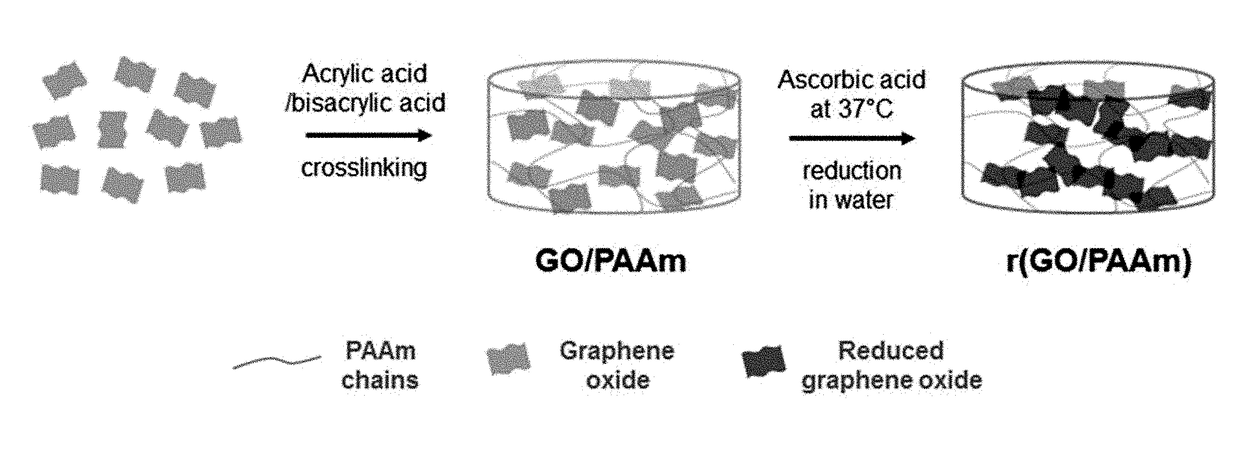Method for preparing hydrogel containing reduced graphene oxide
a graphene oxide and hydrogel technology, applied in the direction of inorganic non-active ingredients, aerosol delivery, prosthesis, etc., can solve the problems of adversely affecting human health, difficulty in treating contaminated water containing large amounts of organic compounds and heavy metals, and long-known seriousness of water pollutants, so as to improve the dye adsorption capacity
- Summary
- Abstract
- Description
- Claims
- Application Information
AI Technical Summary
Benefits of technology
Problems solved by technology
Method used
Image
Examples
example 1
on and Reduction of Graphene-Loaded Alginate Hydrogel
[0055]In this example, a graphene-loaded alginate hydrogel was prepared by mixing graphene oxide with an aqueous alginic acid solution to obtain a graphene oxide-containing hydrogel and reducing the graphene oxide. The graphene-loaded alginate hydrogel was effective in terms of adsorption capacity over a reduced graphene oxide-loaded hydrogel prepared by a conventional method. Since reduced graphene oxide tends to stack due to its hydrophobic interaction, effective dye adsorption capacity of conventional reduced graphene oxide-loaded hydrogels cannot be expected despite the presence of the same amount of graphene oxide (see FIG. 1).
[0056]Specifically, sodium alginate (FMC biopolymer) was added in such an amount that its concentration in a 2 mg / mL aqueous solution of graphene oxide (Graphene supermarket) was 2 wt %. The mixture solution was stirred at 200 rpm for 12 h. Thereafter, the alginic acid / graphene oxide mixture solution wa...
example 2
on and Reduction of Graphene-Loaded Polyacrylamide Hydrogel
[0067]In this example, a graphene-loaded polyacrylamide hydrogel was prepared by mixing graphene oxide with an aqueous acrylamide solution to obtain a graphene oxide-containing hydrogel and reducing the graphene oxide with vitamin C. The graphene-loaded polyacrylamide hydrogel can be applied to myocardial patches with uniform electrical conductivity and elasticity, unlike a reduced graphene oxide-loaded hydrogel prepared by a conventional method (see FIG. 2).
[0068]Specifically, 2.64 mL of an aqueous solution containing acrylamide and bisacrylamide in a weight ratio of 29:1, 4 mL of a 6 mg / mL graphene oxide solution (Graphene supermarket), and 1.36 mL of distilled water were mixed at 0° C., and 80 μL of ammonium peroxosulfate was added thereto. Thereafter, 7-8 mL of the resulting solution was placed in casting stands (Bio-rad) at 1-mm intervals and gelled at 60° C. for 4 h. The resulting hydrogels were reduced with vitamin C ...
PUM
| Property | Measurement | Unit |
|---|---|---|
| Molecular weight | aaaaa | aaaaa |
| Efficiency | aaaaa | aaaaa |
| Adsorption capacity | aaaaa | aaaaa |
Abstract
Description
Claims
Application Information
 Login to View More
Login to View More - R&D
- Intellectual Property
- Life Sciences
- Materials
- Tech Scout
- Unparalleled Data Quality
- Higher Quality Content
- 60% Fewer Hallucinations
Browse by: Latest US Patents, China's latest patents, Technical Efficacy Thesaurus, Application Domain, Technology Topic, Popular Technical Reports.
© 2025 PatSnap. All rights reserved.Legal|Privacy policy|Modern Slavery Act Transparency Statement|Sitemap|About US| Contact US: help@patsnap.com



